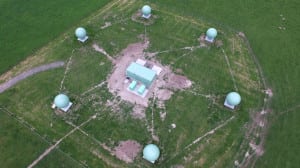McMurdo Completes Asia Pacific MEOSAR Ground Station Installation in New Zealand

McMurdo’s next-generation MEOSAR satellite ground station system installation in New Zealand. Photo: Business Wire
[Via Satellite 11-11-2015] McMurdo has completed the installation of a six-antenna next-generation Medium-Earth Orbit Search and Rescue (MEOSAR) satellite ground station system in New Zealand. McMurdo expects the project, which is part of a joint initiative with Maritime New Zealand and the Australian Maritime Safety Authority, to significantly boost search and rescue capability in the New Zealand and Australia search regions. MEOSAR is the next-generation version of Cospas-Sarsat, the international search and rescue satellite system that has helped save lives since 1982.
In a typical satellite-based search and rescue scenario, ships, aircraft or individuals transmit distress signals from an emergency location beacon via satellite to a fixed ground receiving station or local user terminal. The ground station receives and calculates the location of the distress signal and creates and sends an alert to the appropriate rescue authorities. Today, the beacon-to-alert process depends on a limited number of Low Earth Orbit (LEO) satellites and may take several hours before a position is confirmed. With MEOSAR, beacon signals will be received more quickly and beacon locations identified with greater accuracy thereby reducing this time to minutes, according to McMurdo.
“Beacons can take the ‘search’ out of search and rescue, and the MEOSAR system will dramatically increase the global search and rescue capability,” said Maritime New Zealand Director Keith Manch. “Emergency distress beacons are key equipment for anyone operating at sea, on land, and in the air — whether commercially or recreationally — but they can’t operate without sites like this.”
The New Zealand MEOSAR system, and another being installed in Western Australia, will cover one of the largest search and rescue areas in the world — from north of Australia/New Zealand to the Equator and south to the South Pole, east to half way across the Pacific, and west half way across the Indian Ocean. The systems will undergo rigorous testing before being officially brought online in late 2017 by Cospas-Sarsat.